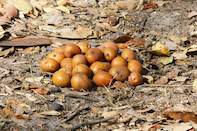Mobola plum (Parinari curatellifolia) is also known as the hissing tree, grysappel or bosappel, Mmola, Mbulwa, Mobola, Muvhula and Umkhuna. The spreading mushroom-shape crown of the mobola plum is recognisable where it grows in the wild - in Swaziland, Zimbabwe and the Mpumalanga and Limpopo provinces of South Africa.

The tree has two-coloured leaves (the underside of the leaf is silver-white) and produces clusters of sweet-smelling, trumpet-shaped flowers from July to November. Flowers produce abundant nectar and pollen for bees and is therefore popular with bee farmers. The large tree with its corky bark produces delicious plum-size fruit with yellow edible flesh.
The ripe fruit is edible raw, dried, cooked as porridge, crushed to extract the juice or fermented into beer. The oil-rich seed is eaten alone (it tastes like almonds), crushed and used to cook soup or mixed in with vegetables. Oil extracted from the nuts can be used for cooking.
Medicinal applications of the mobola plum include using the bark and leaf extracts for pneumonia symptoms, cataracts and earache. Crushed leaves can be used as a dressing for broken bones or dislocations as well as to heal sores and cuts.
Mobola wood contains silica which makes it difficult to work with, but is very durable and used for mining struts, poles and canoes or boats.The tree prefers well-drained, sandy (and acidic) soil but is sensitive to cold weather and winds.